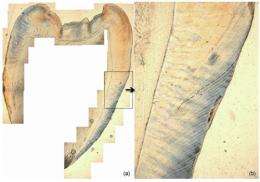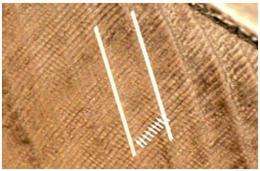Fossil Pongo showing different periodicity of Retzius lines

Periodicity of Retzius lines of primates is a key factor in dental development, and provides information on classification, evolution and adaptation of hominoids in different times and areas. Paleoanthropologists from Institute of Vertebrate Paleontology and Paleoanthropology (IVPP), Chinese Academy of Sciences, examined the periodicity of Retzius lines in fossil Pongo from South China using polarized light microscope observation of dental ground sections. They found the periodicities for all of the 15 teeth were 9 d, and compared it with those in extant primates, fossil apes and hominins. This study was published in Chinese Science Bulletin (Vol.57, No.7) in March 2012.
Pongo is the only great ape in Asia, living in the tropical forest of Kalimantan and Sumatra now. Fossil records indicate that Pongo had once widely distributed in Southeast Asia and South China in Pleistocene. Fossil Pongo from South China was classified into a subspecies of Pongo pygmaeus, Pongo pygmaeus weidenreichi, to distinguish them from those of Indonesian Pongo.

Thousands of Pongo teeth from more than 30 sites dating from early to late Pleistocene have been found in China. Fifteen Pongo teeth with complete crowns and with little or slight worn edges and crests were selected for this study from the Pleistocene of Guangxi, unearthed by a Guangxi field investigation team of the IVPP during the 1950s–1960s.
Fifteen teeth were all cut across the mesial cusps in a buccallingual Plane. Retzius lines were observed firstly at 50× magnification under a Leica polarizing light microscope. An area with clear cross-striations was then selected to count the number of cross-striations between successive Retzius lines, which was the periodicity of Retzius lines.
Researchers found the periodicities for all 15 teeth were 9 d. Periodicity of fossil Pongo from South China was relatively long but fell within the variation of extant Pongo, Gorilla and modern human, and longer than periodicity of Pan and other extant primates. Fossil Pongo from South China was similar to Lufengpithecus and Sivapithecus, shorter than Gigantopithecus and longer than European and African fossil apes and most early hominins in periodicity. Generally, the periodicities of Asian large-body fossil apes were longer than the periodicities of European and African large-body fossil apes in Miocene.
After analyzing difference among species and trend of evolution in periodicity, researchers found that periodicity might gradually increase from Proconsul in early Miocene to several fossil apes in Miocene and then Gigantopithecus in Pleistocene. In addition, correlation between periodicity and body mass respectively in males and females of six extant apes and five fossil apes, indicates that periodicity positively correlated with body mass.
More information:
Hu R, Zhao L X, Wu X Z. Periodicity of Retzius lines in fossil Pongo from South China. Chin Sci Bull, 2012, 57: 790-794, doi: 10.1007/s11434-011-4883-3.
csb.scichina.com:8080/kxtb/CN/ … olumn/current.shtml#
Journal information: Chinese Science Bulletin
Provided by Institute of Vertebrae Paleontology and Paleoanthropology




















